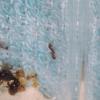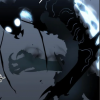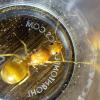- Formiculture.com
- Forums
- Gallery
- Members
- Member Map
- Chat

Questions about camponotus subbarbatus queens.
Started By
LIExotics
, Apr 22 2022 8:05 PM
6 replies to this topic
#1
 Offline
-
Posted April 22 2022 - 8:05 PM
Offline
-
Posted April 22 2022 - 8:05 PM
Hey everyone.
So about a week back, I found a group of queens to Camponotus subbarbatus.
I posted a bunch of pics from them in the ants ID portion to ID them since I'd never seen them before.
But now I have much better pictures, and I'd like to see what everyone has to say about them. My biggest question is, are they fertile and how can I tell?
I've read so many contradicting things about this species, from some sources saying they are polygynos and others not, and some sources saying that they may leave their wings on until they have 15 or more workers, and others saying they drop wings right away.
So I'm not sure.
I really am hoping that they are fertile. But I have no clue. Any information would be great.
This is the link to the images since I don't know how to include pics in the post here:
https://imgur.com/gallery/uTjcVWT
Thanks for any information everyone.
So about a week back, I found a group of queens to Camponotus subbarbatus.
I posted a bunch of pics from them in the ants ID portion to ID them since I'd never seen them before.
But now I have much better pictures, and I'd like to see what everyone has to say about them. My biggest question is, are they fertile and how can I tell?
I've read so many contradicting things about this species, from some sources saying they are polygynos and others not, and some sources saying that they may leave their wings on until they have 15 or more workers, and others saying they drop wings right away.
So I'm not sure.
I really am hoping that they are fertile. But I have no clue. Any information would be great.
This is the link to the images since I don't know how to include pics in the post here:
https://imgur.com/gallery/uTjcVWT
Thanks for any information everyone.
#2
 Offline
-
Posted April 22 2022 - 8:17 PM
Offline
-
Posted April 22 2022 - 8:17 PM
Hey everyone.
So about a week back, I found a group of queens to Camponotus subbarbatus.
I posted a bunch of pics from them in the ants ID portion to ID them since I'd never seen them before.
But now I have much better pictures, and I'd like to see what everyone has to say about them. My biggest question is, are they fertile and how can I tell?
I've read so many contradicting things about this species, from some sources saying they are polygynos and others not, and some sources saying that they may leave their wings on until they have 15 or more workers, and others saying they drop wings right away.
So I'm not sure.
I really am hoping that they are fertile. But I have no clue. Any information would be great.
This is the link to the images since I don't know how to include pics in the post here:
https://imgur.com/gallery/uTjcVWT
Thanks for any information everyone.
There is no possible way to tell that a queen had mated unless you witness the queen mating with at least one male. I can't really say if this species is polygynous or not as I have never kept them. But I think you should stick to the information provided by trusted websites.
- ZTYguy, azzaaazzzz00 and lazyant like this
"If an ant carries an object a hundred times it's weight,you can carry burdens many times your size.
#3
 Offline
-
Posted April 22 2022 - 8:25 PM
Offline
-
Posted April 22 2022 - 8:25 PM
Signs for a mated and fertile queen are non existent. Even when you see brood there is no way of telling if the queen is fertile as many species will just produce male alates when infertile. Also wings for the most part don’t tell you if the queen is mated. I generally don’t pay attention to wings and treat each queen as if she will produce workers but if she doesn’t I simply wait until her eminent demise.
Currently: Considering moving to Australia
Reason: Myrmecia
Reason: Myrmecia
#4
 Offline
-
Posted April 22 2022 - 9:07 PM
Offline
-
Posted April 22 2022 - 9:07 PM
If I'm being completely honest, I wouldn't get your hopes up. I don't know where you found them, but as far as I know, C. subbarbatus have not flown yet in New York, and likely won't for the next month or so. I also have seen no solid evidence that this species is polygynous, and in my experience dealate queens collected from flights would fight on-contact. The fact that you have two alates cooperating and not laying eggs a month before their flights is a pretty surefire sign that you just collected alates from an existing colony, and that they are not fertile. I could be wrong about this, but all I'm saying is that you probably don't want to get your hopes up.
- ZTYguy likes this
#5
 Offline
-
Posted April 23 2022 - 3:21 AM
Offline
-
Posted April 23 2022 - 3:21 AM
Take a deep breath and work your patience muscles. Legit flights in the Mid-Atlantic should start in a matter of weeks.
- CheetoLord02 likes this
"The ants are a people not strong, yet they prepare their meat in the summer." Prov. 30:25
Keep ordinary ants in extraordinary ways.
Keep ordinary ants in extraordinary ways.
#6
 Offline
-
Posted April 23 2022 - 10:47 AM
Offline
-
Posted April 23 2022 - 10:47 AM
If I'm being completely honest, I wouldn't get your hopes up. I don't know where you found them, but as far as I know, C. subbarbatus have not flown yet in New York, and likely won't for the next month or so. I also have seen no solid evidence that this species is polygynous, and in my experience dealate queens collected from flights would fight on-contact. The fact that you have two alates cooperating and not laying eggs a month before their flights is a pretty surefire sign that you just collected alates from an existing colony, and that they are not fertile. I could be wrong about this, but all I'm saying is that you probably don't want to get your hopes up.
While in some cases C. subbarbatus can be polygynous (I've seen a couple people with multi-queen colonies), I wouldn't expect to find their queens so early in NY. If they aren't alates collected from a colony, they are likely alates who were ejected from their colony early for some reason.
- CheetoLord02 likes this
#7
 Offline
Guest_SolenopsisKeeper_*
-
Posted April 23 2022 - 4:14 PM
Offline
Guest_SolenopsisKeeper_*
-
Posted April 23 2022 - 4:14 PM
While in some cases C. subbarbatus can be polygynous (I've seen a couple people with multi-queen colonies), I wouldn't expect to find their queens so early in NY. If they aren't alates collected from a colony, they are likely alates who were ejected from their colony early for some reason.If I'm being completely honest, I wouldn't get your hopes up. I don't know where you found them, but as far as I know, C. subbarbatus have not flown yet in New York, and likely won't for the next month or so. I also have seen no solid evidence that this species is polygynous, and in my experience dealate queens collected from flights would fight on-contact. The fact that you have two alates cooperating and not laying eggs a month before their flights is a pretty surefire sign that you just collected alates from an existing colony, and that they are not fertile. I could be wrong about this, but all I'm saying is that you probably don't want to get your hopes up.
In some species, ants will eject queens of “less dominance” or straight away kill them. Maybe something like that? Or, these ants were lost in the madness of someone disturbing their nest, did this with Floridanus by disturbing the nest, and the alates never returned. I later found dead alates that week.
0 user(s) are reading this topic
0 members, 0 guests, 0 anonymous users





















